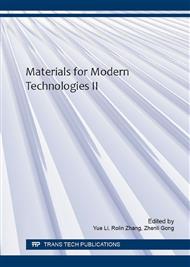[1]
W. J. W. Bakker, F. Kapteijn and J. A. Moulijn, A high capacity manganese-based sorbent for regenerative high temperature desulfurization with direct sulfur production Conceptual process application to coal gas cleaning, Chemical Engineering Journal 96 (2003).
DOI: 10.1016/j.cej.2003.08.022
Google Scholar
[2]
H. X. Cheng and X. L. Luo: Mechanic Automation and Control Engineering (MACE), 2011 Second International Conference on (Hohhot, 15-17 July 2011) 7170-7172.
Google Scholar
[3]
C. Descamps, C. Bouallou and M. Kanniche, Efficiency of an Integrated Gasification Combined Cycle (IGCC) power plant including CO2 removal, Energy 33 (2008) 874–881.
DOI: 10.1016/j.energy.2007.07.013
Google Scholar
[4]
Y. Zhang, B. S. Liu, F. M. Zhang and Z. F. Zhang, Formation of (FexMn2−x) O3 solid solution and high sulfur capacity properties of Mn-based/M41 sorbents for hot coal gas desulfurization, Journal of Hazardous Materials 248- 249 (2013) 81- 88.
DOI: 10.1016/j.jhazmat.2012.12.053
Google Scholar
[5]
H. L. Fan, K. C. Xie, J. Shangguan, F. Shen and C. H. Li, Effect of Calcium Oxide Additive on the Performance of Iron Oxide Sorbent for High-Temperature Coal Gas Desulfurization, Journal of Natural Gas Chemistry 16 (2007) 404–408.
DOI: 10.1016/s1003-9953(08)60012-2
Google Scholar
[6]
P. R. Westmoreland and D. P. Harrison, Evaluation of candidate solids for high-temperature desulfurization of low-Btu gases, Environ. Sci. Technol. 10 (1976) 659–661.
DOI: 10.1021/es60118a010
Google Scholar
[7]
J. Mi, M. Yu, F. Y. Yuan and J. C. Wang, Regeneration Characteristics and Kinetics of Modified Semi-coke Supported (Fe, Zn, Ce) Desulfurization Sorbents, Energy Fuels 26 (2012) 6551–6558.
DOI: 10.1021/ef301222c
Google Scholar
[8]
J. Wang, B. Liang and R. Parnas, Manganese-based regenerable sorbents for high temperature H2S removal, Fuel 107 (2013) 539–546.
DOI: 10.1016/j.fuel.2012.10.076
Google Scholar
[9]
V. Girard, A. Baudot, D. Chiche, D. Bazer-Bachi, C. Bounie, C. Geantet, Rational selection of single oxide sorbents for syngas desulfurization regenerable at reduced temperature: Thermochemical calculations and experimental study, Fuel 128(2014).
DOI: 10.1016/j.fuel.2014.02.058
Google Scholar
[10]
J. Mu, D.D. Perlmutter, Thermal decomposition of inorganic sulfates and their hydrates, Ind Eng Chem Proc Des Dev, 20 (1981) 640–646.
DOI: 10.1021/i200015a010
Google Scholar
[11]
H. F. Su, J. L. Gao, Y. X. Wen, Z. F. Tong and X. H. Li, Preparation of High Purity Hausmannite by Solid Phase Decomposition of Manganese Sulphate, Nonferrous Metals. 4 (2008) 47-50.
Google Scholar
[12]
D. Karayilan, T. Dogu, S. Yasyerli, G. Dogu, Mn–Cu and Mn–Cu–V mixed oxide regenerable sorbents for hot gas desulfurization, Ind. Eng. Chem. Res. 44 (2005) 5221–5226.
DOI: 10.1021/ie0492496
Google Scholar


